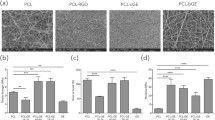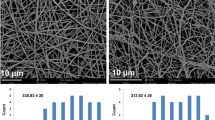Abstract
Cutaneous wound healing is complex, requiring a coordinated response by growth factors, drugs, and resident cells of the skin. To simulate native extracellular matrix, electrospun nanofibers offer a favorable microenvironment for biological processes, generating considerable interest in skin tissue regeneration. Furthermore, among the most essential growth factors in wound healing, basic fibroblast growth factor (bFGF) promotes cell migration, proliferation, and differentiation, thus enhancing wound healing. However, its application is limited by a short half-life and loss of bioactivity in normal physiological conditions when used in its naked form and without stabilization. Hence, delivering the growth factor with a controllable releasing speed constitutes a challenge. The aim of this study was to create a growth factor-releasing system that allows for time-controlled release to facilitate skin regeneration. Electrospun collagen-graphene oxide (Col-GO) scaffolds loaded with bFGF were fabricated. The cumulative release rate of the Col-0.2% GO-bFGF group was 30.94 ± 7.77%, which was superior to the other groups. Moreover, core–shell structured Col/GO and polylactic acid (PLA) nanofibers were fabricated by coaxial electrospinning in the attempt of reducing the degradation rate of the scaffolds (Col-GO). The ability of the materials to promoting wound healing in vitro and in vivo was investigated, and the improved skin tissue recovery with the growth factor release system was demonstrated. Importantly, bFGF was sustained-released through the constructed systems, leading to the best wound healing performance when the scaffolds contained the growth factor. The healing rates of Col-GO and core–shell scaffolds loaded with bFGF were 96.39 ± 0.66% and 92.29 ± 0.42%, respectively.
Graphical abstract
Col-GO and PLA through coaxial electrospinning to form core–shell fiber scaffolds for skin tissue engineering applications









Similar content being viewed by others
References
Chen L, Xing Q, Zhai Q et al (2017) Pre-vascularization enhances therapeutic effects of human mesenchymal stem cell sheets in full thickness skin wound repair. Theranostics 7(1):117–131. https://doi.org/10.7150/thno.17031
Martin P (1997) Wound healing--aiming for perfect skin regeneration. Science 276(5309): 75–81.https://doi.org/10.1126/science.276.5309.75
Lo ZJ, Lim X, Eng D et al (2020) Clinical and economic burden of wound care in the tropics: a 5-year institutional population health review. Int Wound J 17(3): 790–803. https://doi.org/10.1111/iwj.13333
Sen CK (2021) Human wound and its burden: updated 2020 compendium of estimates. Adv Wound Care (New Rochelle) 10(5): 281–292. https://doi.org/10.1089/wound.2021.0026
Guest JF, Ayoub N, McIlwraith T et al (2017) Health economic burden that different wound types impose on the UK's National Health Service. Int Wound J 14(2):322–330. https://doi.org/10.1111/iwj.12603
Guo S, Dipietro LA (2010) Factors affecting wound healing. J Dent Res 89(3): 219–229. https://doi.org/10.1177/0022034509359125
Pallaske F, Pallaske A, Herklotz K et al (2018) The significance of collagen dressings in wound management: a review. J Wound Care 27(10):692–702. https://doi.org/10.12968/jowc.2018.27.10.692
Tao SC, Guo SC, Li M et al (2017) Chitosan wound dressings incorporating exosomes derived from MicroRNA-126-overexpressing synovium mesenchymal stem cells provide sustained release of exosomes and heal full-thickness skin defects in a diabetic rat model. Stem Cells Transl Med 6(3):736–747. https://doi.org/10.5966/sctm.2016-0275
Chouhan D, Mandal BB (2020) Silk biomaterials in wound healing and skin regeneration therapeutics: From bench to bedside. Acta Biomater 103:24–51. https://doi.org/10.1016/j.actbio.2019.11.050
Zheng L, Li S, Luo J et al (2020) Latest advances on bacterial cellulose-based antibacterial materials as wound dressings. Front Bioeng Biotechnol 8:593768. https://doi.org/10.3389/fbioe.2020.593768
Choi S, Zo S, Park G et al (2020) Preparation of Waterborne Polyurethane-Based Macroporous Sponges as Wound Dressings. J Nanosci Nanotechnol 20(8):4634–4637. https://doi.org/10.1166/jnn.2020.17827
Wang X, Ding B, Li B (2013) Biomimetic electrospun nanofibrous structures for tissue engineering. Mater Today (Kidlington) 16(6): 229–241. https://doi.org/10.1016/j.mattod.2013.06.005
Wang C, Chu C, Zhao X et al (2021) The diameter factor of aligned membranes facilitates wound healing by promoting epithelialization in an immune way. Bioactive Materials 11:206–217. https://doi.org/10.1016/j.bioactmat.2021.09.022
Urbanczyk M, Layland SL, Schenke-Layland K (2020) The role of extracellular matrix in biomechanics and its impact on bioengineering of cells and 3D tissues. Matrix Biology 85–86:1–14. https://doi.org/10.1016/j.matbio.2019.11.005
Boni BOO, Lamboni L, Bakadia BM et al (2020) Combining silk Sericin and surface micropatterns in bacterial cellulose dressings to control fibrosis and enhance wound healing. Engineered Science 10:68–77. https://doi.org/10.30919/es8d906
Dong Y, Kong J, Phua SL et al (2014) Tailoring surface hydrophilicity of porous electrospun nanofibers to enhance capillary and push-pull effects for moisture wicking. ACS Appl Mater Interfaces 6(16):14087–14095. https://doi.org/10.1021/am503417w
Zhang L, Wang Z, Xiao Y et al (2018) Electrospun PEGylated PLGA nanofibers for drug encapsulation and release. Mater Sci Eng C Mater Biol Appl 91:255–262. https://doi.org/10.1016/j.msec.2018.05.045
Ziyadi H, Baghali M, Bagherianfar M et al (2021) An investigation of factors affecting the electrospinning of poly (vinyl alcohol)/kefiran composite nanofibers. Adv Compos Hybrid Mater 1–12. https://doi.org/10.1007/s42114-021-00230-3
Liu Y, Chen X, Liu Y et al (2022) Electrospun coaxial fibers to optimize the release of poorly water-soluble drug. polymers (Basel) 14(3):469. https://doi.org/10.3390/polym14030469
Zhou H, Shi Z, Wan X et al (2019) The relationships between process parameters and polymeric nanofibers fabricated using a modified coaxial electrospinning. Nanomaterials (Basel) 9(6):843. https://doi.org/10.3390/nano9060843
Zhang M, Song W, Tang Y et al (2022) Polymer-Based Nanofiber-Nanoparticle Hybrids and Their Medical Applications. Polymers (Basel) 14(2):351. https://doi.org/10.3390/polym14020351
Ning T, Zhou Y, Xu H et al (2021) Orodispersible membranes from a modified coaxial electrospinning for fast dissolution of diclofenac sodium. Membranes (Basel) 11(11):802. https://doi.org/10.3390/membranes11110802
Cai S, Liu Y, Zheng Shu X et al (2005) Injectable glycosaminoglycan hydrogels for controlled release of human basic fibroblast growth factor. Biomaterials 26(30): 6054–6067. https://doi.org/10.1016/j.biomaterials.2005.03.012
Julier Z, Park AJ, Briquez PS et al (2017) Promoting tissue regeneration by modulating the immune system. Acta Biomater 53:13–28. https://doi.org/10.1016/j.actbio.2017.01.056
Chen L, Liu J, Guan M et al (2020) Growth factor and its polymer scaffold-based delivery system for cartilage tissue engineering. Int J Nanomedicine 15:6097–6111. https://doi.org/10.2147/ijn.S249829
Nilasaroya A, Kop AM, Morrison DA (2021) Heparin-functionalized hydrogels as growth factor-signaling substrates. J Biomed Mater Res A 109(3): 374–384. https://doi.org/10.1002/jbm.a.37030
Bhattarai RS, Bachu RD, Boddu SHS et al (2018) Biomedical applications of electrospun nanofibers: drug and nanoparticle delivery. Pharmaceutics 11(1):5 https://doi.org/10.3390/pharmaceutics11010005
Xu S, Deng L, Zhang J et al (2016) Composites of electrospun-fibers and hydrogels: a potential solution to current challenges in biological and biomedical field. J Biomed Mater Res B Appl Biomater 104(3): 640–656. https://doi.org/10.1002/jbm.b.33420
Shin SR, Li YC, Jang HL et al (2016) Graphene-based materials for tissue engineering. Adv Drug Deliv Rev 105(Pt B): 255–274. https://doi.org/10.1016/j.addr.2016.03.007
Song HS, Kwon OS, Kim JH et al (2017) 3D hydrogel scaffold doped with 2D graphene materials for biosensors and bioelectronics. Biosens Bioelectron 89(Pt 1): 187–200. https://doi.org/10.1016/j.bios.2016.03.045
Mei Q, Liu B, Han G et al (2019) Graphene oxide: from tunable structures to diverse luminescence behaviors. Adv Sci (Weinh) 6(14): 1900855. https://doi.org/10.1002/advs.201900855
Shamekhi MA, Mirzadeh H, Mahdavi H et al (2019) Graphene oxide containing chitosan scaffolds for cartilage tissue engineering. Int J Biol Macromol 127:396–405. https://doi.org/10.1016/j.ijbiomac.2019.01.020
Zhou M, Lozano N, Wychowaniec JK et al (2019) Graphene oxide: a growth factor delivery carrier to enhance chondrogenic differentiation of human mesenchymal stem cells in 3D hydrogels. Acta Biomater 96:271–280. https://doi.org/10.1016/j.actbio.2019.07.027
Bharadwaz A, Jayasuriya AC (2020) Recent trends in the application of widely used natural and synthetic polymer nanocomposites in bone tissue regeneration. Mater Sci Eng C Mater Biol Appl 110:110698. https://doi.org/10.1016/j.msec.2020.110698
Das P, DiVito MD, Wertheim JA et al (2020) Collagen-I and fibronectin modified three-dimensional electrospun PLGA scaffolds for long-term in vitro maintenance of functional hepatocytes. Mater Sci Eng C Mater Biol Appl 111:110723. https://doi.org/10.1016/j.msec.2020.110723
Homaeigohar S, Boccaccini AR (2020) Antibacterial biohybrid nanofibers for wound dressings. Acta Biomater 107:25–49. https://doi.org/10.1016/j.actbio.2020.02.022
Ucar B, Humpel C (2018) Collagen for brain repair: therapeutic perspectives. Neural Regen Res 13(4): 595–598. https://doi.org/10.4103/1673-5374.230273
Levingstone TJ, Ramesh A, Brady RT et al (2016) Cell-free multi-layered collagen-based scaffolds demonstrate layer specific regeneration of functional osteochondral tissue in caprine joints. Biomaterials 87:69–81. https://doi.org/10.1016/j.biomaterials.2016.02.006
Semenycheva LL, Egorikhina MN, Chasova VO et al (2020) Enzymatic hydrolysis of marine collagen and fibrinogen proteins in the presence of thrombin. Mar Drugs 18(4):208 https://doi.org/10.3390/md18040208
Rong ZJ, Yang LJ, Cai BT et al (2016) Porous nano-hydroxyapatite/collagen scaffold containing drug-loaded ADM-PLGA microspheres for bone cancer treatment. J Mater Sci Mater Med 27(5): 89. https://doi.org/10.1007/s10856-016-5699-0
Li G, Zhao M, Xu F et al (2020) Synthesis and biological application of polylactic acid. Molecules 25(21):5023. https://doi.org/10.3390/molecules25215023
Tyler B, Gullotti D, Mangraviti A et al (2016) Polylactic acid (PLA) controlled delivery carriers for biomedical applications. Adv Drug Deliv Rev 107:163–175. https://doi.org/10.1016/j.addr.2016.06.018
Kim M, Jeong JH, Lee JY et al (2019) Electrically conducting and mechanically strong graphene-polylactic acid composites for 3D printing. ACS Appl Mater Interfaces 11(12): 11841–11848. https://doi.org/10.1021/acsami.9b03241
Barata D, Dias P, Wieringa P et al (2017) Cell-instructive high-resolution micropatterned polylactic acid surfaces. Biofabrication 9(3): 035004. https://doi.org/10.1088/1758-5090/aa7d24
Bürck J, Heissler S, Geckle U et al (2013) Resemblance of electrospun collagen nanofibers to their native structure. Langmuir 29(5): 1562–1572. https://doi.org/10.1021/la3033258
Vukosavljevic B, Murgia X, Schwarzkopf K et al (2017) Tracing molecular and structural changes upon mucolysis with N-acetyl cysteine in human airway mucus. Int J Pharm 533(2): 373–376.https://doi.org/10.1016/j.ijpharm.2017.07.022
Wang S, Wang Z, Foo SE et al (2015) Culturing fibroblasts in 3D human hair keratin hydrogels. ACS Appl Mater Interfaces 7(9): 5187–5198. https://doi.org/10.1021/acsami.5b00854
Selvaraj S, Fathima NN (2017) Fenugreek incorporated silk fibroin nanofibers—a potential antioxidant scaffold for enhanced wound healing. ACS Appl Mater Interfaces 9(7): 5916–5926. https://doi.org/10.1021/acsami.6b16306
Bhardwaj N, Chouhan D, Mandal BB (2017) Tissue engineered skin and wound healing: current strategies and future directions. Curr Pharm Des 23(24): 3455–3482. https://doi.org/10.2174/1381612823666170526094606
Li J, Zhou C, Luo C et al (2019) N-acetyl cysteine-loaded graphene oxide-collagen hybrid membrane for scarless wound healing. Theranostics 9(20): 5839–5853. https://doi.org/10.7150/thno.34480
Zeng Y, Zhou M, Chen L et al (2020) Alendronate loaded graphene oxide functionalized collagen sponge for the dual effects of osteogenesis and anti-osteoclastogenesis in osteoporotic rats. Bioact Mater 5(4): 859–870. https://doi.org/10.1016/j.bioactmat.2020.06.010
Finnerty CC, Jeschke MG, Branski LK et al (2016) Hypertrophic scarring: the greatest unmet challenge after burn injury. Lancet 388(10052): 1427–1436. https://doi.org/10.1016/s0140-6736(16)31406-4
Acknowledgements
This work was supported by the National Key R&D Program of China (2019YFA0110500), the National Natural Science Foundation of China (No. 81501674), and Provincial Natural Science of Hubei (2018CFB489).
Author information
Authors and Affiliations
Contributions
All authors contributed to the study conception and design. Material preparation, data collection, and analysis were performed by [Jialong Chen], [Guo Zhang], [Yang Zhao], [Muran Zhou], [Aimei Zhong], and [Jiaming Sun]. The first draft of the manuscript was written by [Jialong Chen] and all authors commented on previous versions of the manuscript. All authors read and approved the final manuscript.
Corresponding authors
Ethics declarations
Conflict of interest
The authors declare no conflict of interest.
Additional information
Publisher's Note
Springer Nature remains neutral with regard to jurisdictional claims in published maps and institutional affiliations.
Rights and permissions
About this article
Cite this article
Chen, J., Zhang, G., Zhao, Y. et al. Promotion of skin regeneration through co-axial electrospun fibers loaded with basic fibroblast growth factor. Adv Compos Hybrid Mater 5, 1111–1125 (2022). https://doi.org/10.1007/s42114-022-00439-w
Received:
Revised:
Accepted:
Published:
Issue Date:
DOI: https://doi.org/10.1007/s42114-022-00439-w




